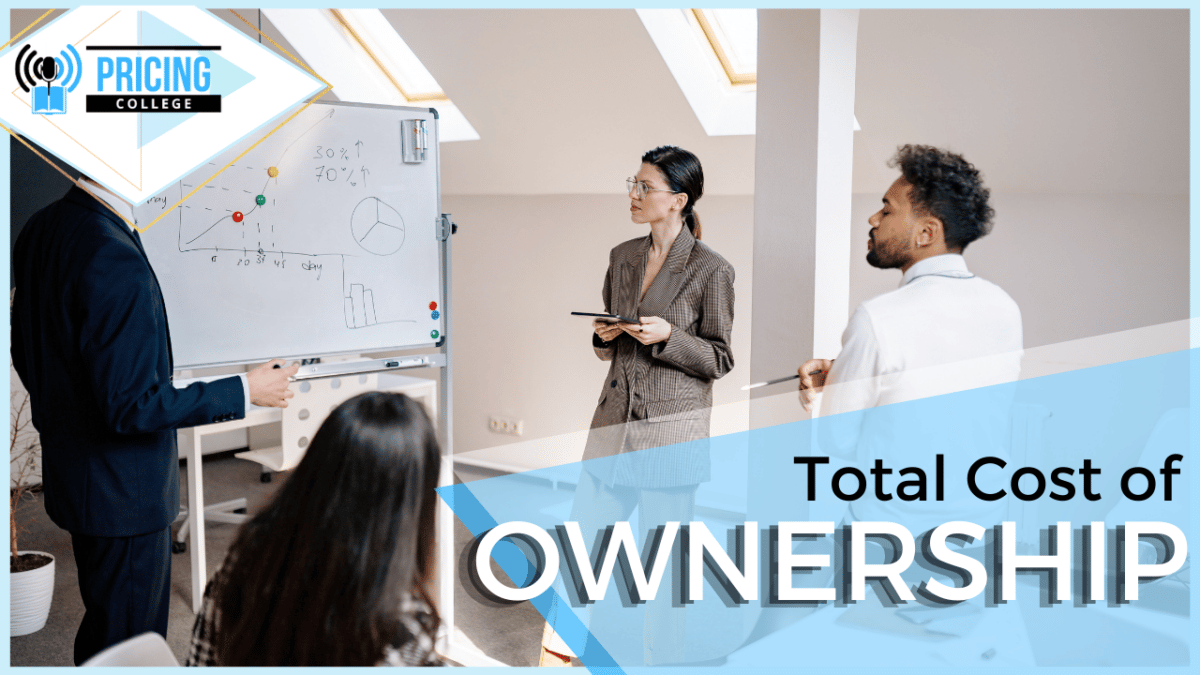
What is Total Cost Of Ownership!🏷️ Podcast Ep. 19
In this episode of Pricing College – Joanna and Aidan discuss the concept of Total Cost Of Ownership. We all know that Duracell batteries claim to last longer than other batteries. If it lasts longer, could it be cheaper in the long term versus buying cheaper options more frequently?
We look at this concept in the world of procurement, value-based selling, and sectors such as cars etc.
Listen on Apple Podcasts Listen on Spotify Listen on Google Podcasts Listen on Stitcher Listen on Amazon Music
TIME-STAMPED SHOW NOTES:
[00:00] Introduction
[03:12] Total cost of ownership
[05:41] Total cost of ownership and the benefits of your product in negotiation with procurement
[06:53] Understand upfront and longer-term costs, direct and indirect costs, and hidden obvious costs.
Have you ever been in a sales call with procurement and thought, “Gosh, I want to get out of this price unit price discussion but I just don’t know how.”
Or perhaps you are in a discussion with procurement and you’ve given them the lowest price. And you’re thinking, “why don’t they go with me?” And then they call you up and say “Look, we’ve decided to go with another supplier.”
So, today what we’re going to do, we’re going to talk about another important procurement technique and measurement that we believe suppliers should know about.
And this is called the total cost of ownership measure.
Now, this is an important concept for suppliers because often this is something they will judge you on. So, yeah, we’re going to talk about what it is and why it’s important.
I think anyone who’s ever had an addiction to shopping, or buying clothes, etc., you can often justify buying more expensive items. So, say you go to buy a new coat. You can buy a fast fashion coat that may cost you $5 or $10. It sounds cheap on the initial price tag, but you might only wear it once.
After the first wash, it might look terrible. The alternative is a much more expensive coat. Something that looks great, but you could keep it for 20 years. You could wear it to important meetings. And you might even get a better job from going to an interview in it.
When you look at the cost of owning that coat over the 20 year period that you have it in, maybe you have to buy 20 times the cheaper coat. And the actual more expensive one, on a price tag basis might work out cheaper.
The other classic example I’ll give is batteries for your remote control of any electronic device. Famously, Duracell batteries are supposed to last x times longer than a cheaper alternative. So you may buy a cheaper battery.
But how many batteries do you have to buy over the lifetime of the supposedly more expensive Duracell? Realistically, it might be cheaper and save you the hassle.
I suppose, to summarise the total cost of ownership looks at the complete costs of owning something once it’s bought, like from purchase to disposal.
When procurement listens to your sales calls, they’re not just looking at the unit price. A lot of salespeople think procurement just wants the lowest price not necessarily. Some are looking at the recurring costs involved when they buy your offer.
I think we’re all used to saying you go to buy a car, and now with a lot of cars, specifically some of the newer entrants to the market. I’m thinking of people like Kia, which has built a very big presence here in Australia.
15 years ago, I didn’t even know they exist, but they’re certainly unheard of. They have offered things such as seven-year warranties, whereas a decreasing fixed price servicing.
Math is the decrease in the total cost of ownership for that car over the lifetime of the car. The initial upfront price tag that you pay is only part of the actual cost. You have to look for a car. And you have to look at ancillary costs as well things such as insurance and fuel consumption. Does one car cost a lot more to run than another one?
In some countries, there are even access fees you have to pay for environmental performance. The real cost of owning that car is related obviously to the component of the price tag of the initial purchase. But there are so many other factors to factor into it that you’ll only become aware of when we have to make the cash payment for years down the line.
Another example could be, I’ll take one from my own experience when I was buying a water filter. I was looking at a couple of different suppliers for this water filter. The cost of one was like $485, the cost of the other is more expensive at $695.
The cheaper one could do the job. But when I look closely in terms of doing a job, it could remove heavy metals, etc., filter the water tasted okay. But when I looked closer, between the two of them, the cartridge of the cheaper one was much smaller.
So that would mean, I’d have to replace the cartridge, more frequently. Also, both of them had to be installed by a plumber. The first one didn’t have a free assessment to see how it fits into the house. The second one, the more expensive one did.
So overall, even though the upfront cost of that filter was more expensive at $695, overall, it had a bigger cartridge. I didn’t have to change the cartridge as much over time, had free installation from the plumber and a free assessment. And I thought “You know what, that’s great because I also get advice from the plumber. Is this the right one for me?”
I think if we wrapped it all up where are we trying to go with this. The point of it is when procurement teams are buying any product or service. They’re tasked with a couple of things.
The first one is to get a great price, and a great price is a low price. They want to pay less. But the second thing is they want a better quality product, better quality service and reliability, and a low-risk supplier for their company.
In the negotiation, they’re probably trying to push you down on price. But what you need to be doing is a skilled sales team, a skilled pricing manager.
You need to be aware of the concept of a total cost of ownership. The awareness that what you’re delivering might be cheaper and you need to go to the purchaser. You need to go the procurement team in the direction that I suppose benefits you and takes awareness of the pluses of your offer.
If you have a much longer-lasting product that has been tested, some of these, say a tire that will last $1,000 versus one this test for $500 you need to get that across. You need to be discussing the total cost of ownership and the benefits of your product. Not just the upfront price tag on which you could be pushed down on the apples to apple comparison situation.
It does help both the supplier and procurement to understand, upfront and longer-term costs direct and indirect costs, and hidden obvious costs. The limitation of this concept is that yeah, it’s very cost-focused.
It doesn’t go into all those risks involved in buying a particular product, delivering on time, supply chain issues. Does the product work better than another product? And product innovation is the downside.
But this is something that good salespeople person will go at. I can add to this total cost of ownership concept by discussing risk, by going back into the procurement officers’ problem. We’re escalating that conversation to real needs and not just gravitating to cost. We’re thinking about how the product boosts their revenue not just cut their costs.
They’re thinking about how working with you ensures that they have a safe and protected relationship over time that you’ll help them if they need help. The support is there, it’s not just about the product that you’re selling.
On this podcast, we talk an awful lot about value. But realistically, you can only really dig deep in value when you put yourself in the purchaser or the user’s shoes or seat.
Why is somebody buying your product?
What do they want from your product?
How do they value it?
When you look at it from that perspective, that’s when you can start mapping out the actual total cost of ownership, the benefits, the negatives, and the cost savings that a product or service delivers. When you can do that, then you can discuss it with them. And you can discuss those plus’ that make your product better versus others.
I think we’d cover this much more in all aspects of this will be covered in future podcasts. But I think that’s all I’ve got to say on this one today.
Just remember that you can use concepts from procurement to get out of those difficult sorts of price unit price discussions. You don’t have to be framed by them if you can control that conversation and turn it around to an advantage to benefit you and the person who’s buying from you.

LINKS MENTIONED IN TODAY’S EPISODE:
For a comprehensive view on building a great pricing team to prevent loss in revenue,
Download a complimentary whitepaper on How to Build Hiring Capability To Get The Best Pricing Team
Related Posts
Leave a Reply Cancel reply
Categories
- marketing strategy (26)
- Organisational Design (14)
- Podcast (114)
- Pricing Capability (87)
- Pricing Career Advice (10)
- Pricing Recruitment (19)
- Pricing Strategy (291)
- Pricing Team Skills (13)
- Pricing Teams & Culture (25)
- Pricing Transformation (47)
- Revenue Model (25)
- Sales Effectiveness (27)
- Talent Management (7)
- Technical Pricing Skills (35)





